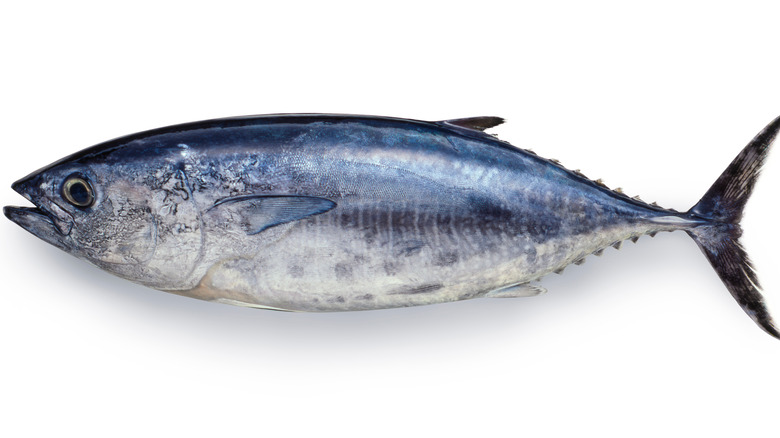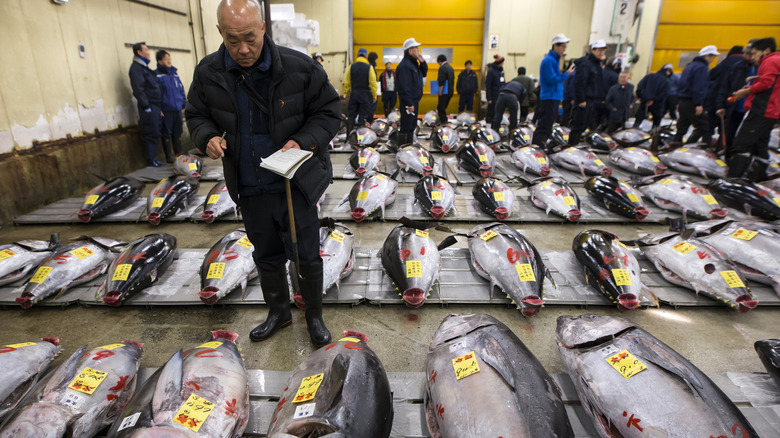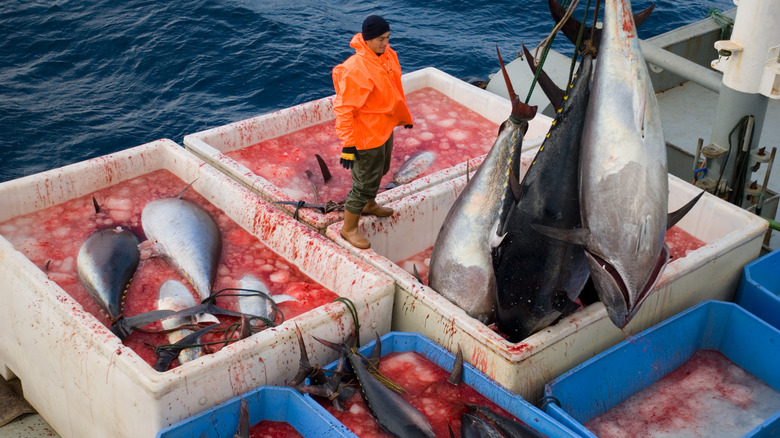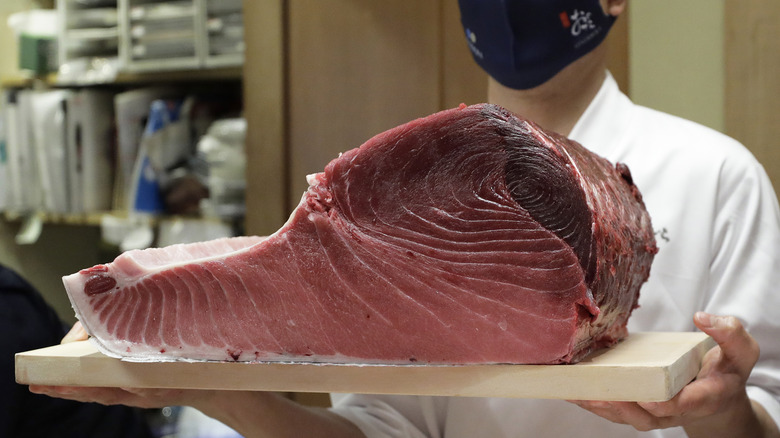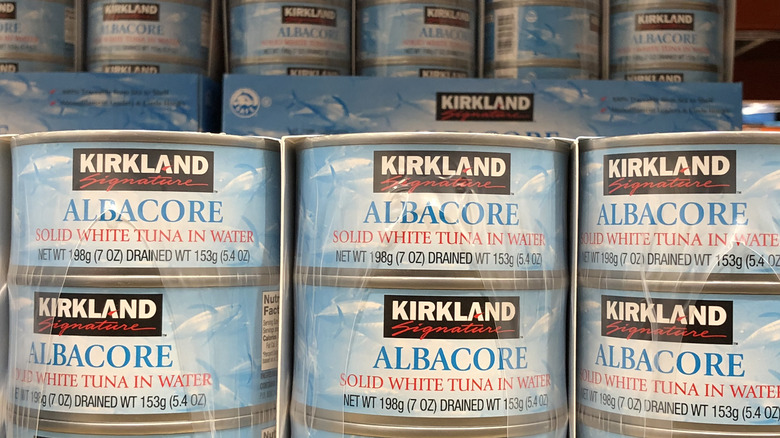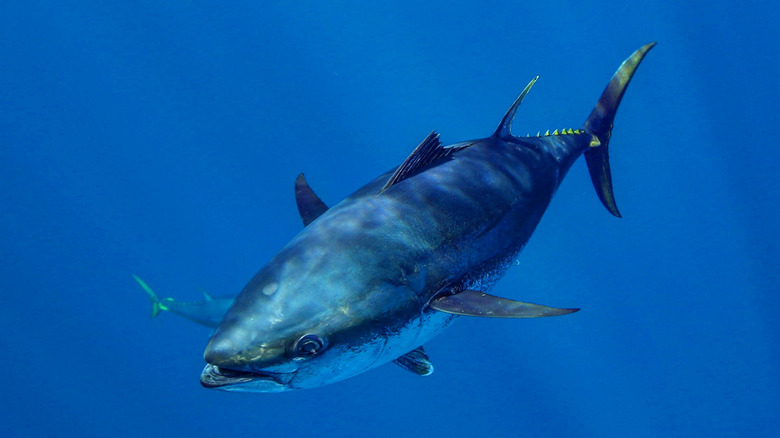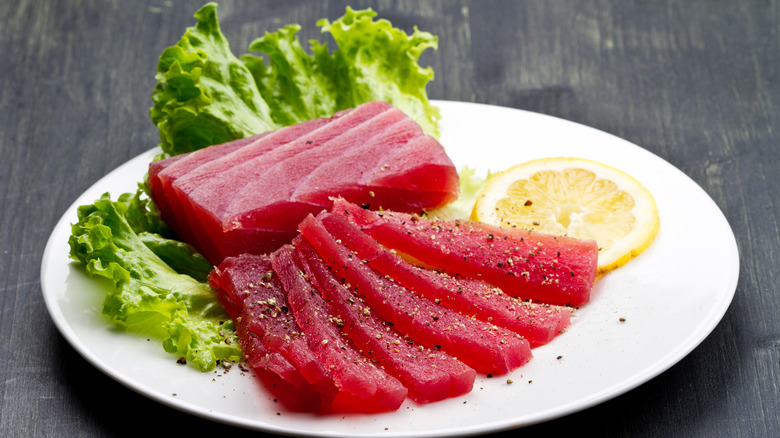What Is Bluefin Tuna And What Is It Used For?
It seems that the pandemic has impacted just about every facet of life around the globe — even the market for the iconic and vastly expensive bluefin tuna, a huge fish prized in sushi and sashimi dishes for its sublime texture and flavor.
As people hunkered down at home, demand fell for the migratory fish, whose belly flesh is considered melt-in-your-mouth delicious. But as the global economy reopens, we'll probably see seafood aficionados coming back for more of the world's biggest tuna that's not only delicious but nutrient-dense to boot.
Because of the crimp COVID-19 put in the restaurant business, the most expensive bluefin sold this year at the first auction of Tokyo's Toyosu fish market brought in only $202,270, according to the Asahi Shimbun. We say "only" because just two years before, a bluefin sold there for more than $3 million, earning it a spot in the Guinness Book of World Records.
Bluefin commands such an extravagant price, even during an economic downturn, because of limited supply and a market, mostly in Japan, that can't get enough of the fatty-fleshed fish.
What is bluefin tuna?
Southern bluefin (Thunnus maccoyii) are found in the southern hemisphere, Pacific bluefin (T.orientalis) swim widely in the northern Pacific Ocean, and Atlantic bluefin (T.thynnus) range in the Atlantic Ocean and Mediterranean Sea (via Biology Dictionary).
Bluefin can live for decades and grow relatively slowly, but that's about the only thing slow about them. With a streamlined shape that's often described as torpedo-like, bluefin tuna are built for speed. They even have eyes that are flush with their body and retractable fins, according to the World Wildlife Fund.
Although bluefin are the largest of the main tuna species, they make up only about 1% of global tuna landings by weight, according to the Pew Charitable Trusts. Smaller skipjack and yellowfin take first and second place, followed by bigeye and albacore.
The WWF notes that due to its high demand, bluefin populations have notably diminished over the years, largely due to "overfishing and illegal fishing." Although bluefin are making a comeback, the International Union for Conservation of Nature notes that the Pacific species "remains severely depleted at less than 5% of its original biomass" and is currently classified as endangered.
How are bluefin tuna caught?
Ernest Hemingway, whose book "The Old Man and the Sea" tells the tale of aging tuna fisherman Santiago, fished for bluefin tuna off the coasts of Florida and the Bahamas before they were ravaged by the sushi and sashimi market in Japan, according to Anglers Journal. Hemingway used a hefty rod and reel, as do many sport anglers.
Commercial fishermen also use heavy rods and reels in addition to other industrial methods, like purse-seine nets, which Yale Environment 360 notes surround tuna as they congregate to spawn, or the long-line method, a fishing technique that uses a main line set with baited hooks at intervals. Long-line fishing, The Fish Site notes, has declined in recent years as the purse-seine method has become more popular.
Efforts to raise bluefin on farms in a a process known as aquaculture have been underway for years. But as NPR reports, raising bluefin entirely in captivity has proven particularly difficult, largely because the fish requires so much food.
What does bluefin tuna taste like?
The fish is prized for its use in high-end sushi and sashimi. Derek Wilcox, a chef at a Japanese restaurant in New York, gushed about its culinary characteristics in an interview with Business Insider. "Bluefin is the most sought after," he said. "Only bluefin has the intense marbling. Bluefin also, when it's aged properly, has a particular balance of flavors."
Several parts of the tuna can be turned into sushi, but you can expect to find two categories at most sushi restaurants: akami and toro. Akami is lean flesh from the sides of the fish, while toro is fattier and more expensive. Toro comes in two varieties — chutoro is the side belly area and otoro describes cuts from the fish's underside.
Excellent otoro can only be found in bluefin tuna, according to French fish supplier Chez Laurent in OnboardOnline. "This cut is fatty almost to the point of falling apart and can literally melt in your mouth," the fish supplier said, going on to describe the cut as having a "sirloin feel" that "charms the majority of people as soon as they sample it."
Bluefin vs. other types of tuna
Probably the main difference between bluefin and other types of tuna is that you're much more likely to eat cuts of bluefin — like in sashimi or a seared steak — instead of getting it in a can.
Next time you're at the grocery store, it'll be easy and cheap to pick up some albacore tuna in a can in the form of "solid white" or "chunk white" for some quick weekday protein. If you go with "chunk light," that'll probably be a mix of "skipjack, yellowfin and sometimes bigeye," according to Fulton Fish Market.
Skipjack flesh tends to be darker and have a stronger fish taste, FishingBooker notes, while albacore is lighter and milder. Pale pink yellowfin has a mild flavor while bigeye "boast[s] bright, firm meat, with loads of flavor." Meanwhile, bluefin have "a richness of flavor you just won't find in another fish."
The restaurant chain Sushi by Bou explains that bluefin has "the richest colored and fattiest flesh of all species of tuna" in addition to "a distinctive medium-full flavor and firm, 'meaty' texture with large flakes." FishingBooker points out that, while not as fatty and high-end as bluefin, bigeye tuna is a good choice for someone who wants a "fatty, flavorful" fish-eating experience without breaking the bank.
Nutritional value of bluefin tuna
When you're thinking of healthy protein, fish probably comes to the top of your list. But with bluefin, it's a mixed bag.
According to Localfish.org, a 3.5 ounce serving of western Atlantic bluefin tuna has 144 calories, over 23 grams of protein and a total fat content of just under 5 grams.
In addition to being a good source of protein, the fish also provides thiamin, selenium, vitamin B6, and omega-3 fatty acids, nutritional benefits also found in Pacific bluefin, according to FishWatch.
But like so many other foods, bluefin have pros and cons when it comes to nutrition. Besides the nutrients, the fish also contain higher mercury levels than fish that don't live as long, according to the Mercury Policy Project. The Environmental Defense Fund — which notes that in addition to mercury, bluefin can also have elevated PCB levels — recommends that adults eat no more than one serving per month.
How to cook with bluefin tuna
If you don't have access to dockside markets or specialty grocers, you may have to order bluefin online. However you get it, though, you aren't limited to only eating bluefin as sushi or sashimi.
Fish expert John Susman told Australian food and lifestyle publisher Delicious that the fish is prized for sashimi because the flesh is often softer than that of other types of tuna given its high fat content. But, he added, "it's perfect for braising or to confit at low temperature."
You can also make seared bluefin tuna steaks on the grill, says Traeger Grills, or use a skillet to make this marinated seared bluefin tuna from Harbor Fish Market.
It is possible to get canned bluefin tuna, but a single 6.5 ounce tin can set you back you $20. It can be used in salads, tapas, and "seacuterie" boards, per SoPo Seafood. It's also possible to can your own bluefin.
You can also bake, broil or smoke bluefin. SeafoodSource recommends treating it like you would a sirloin steak: "It's best if done on the rare side. The color will be nice and light, the meat firm and the flavor intense."
